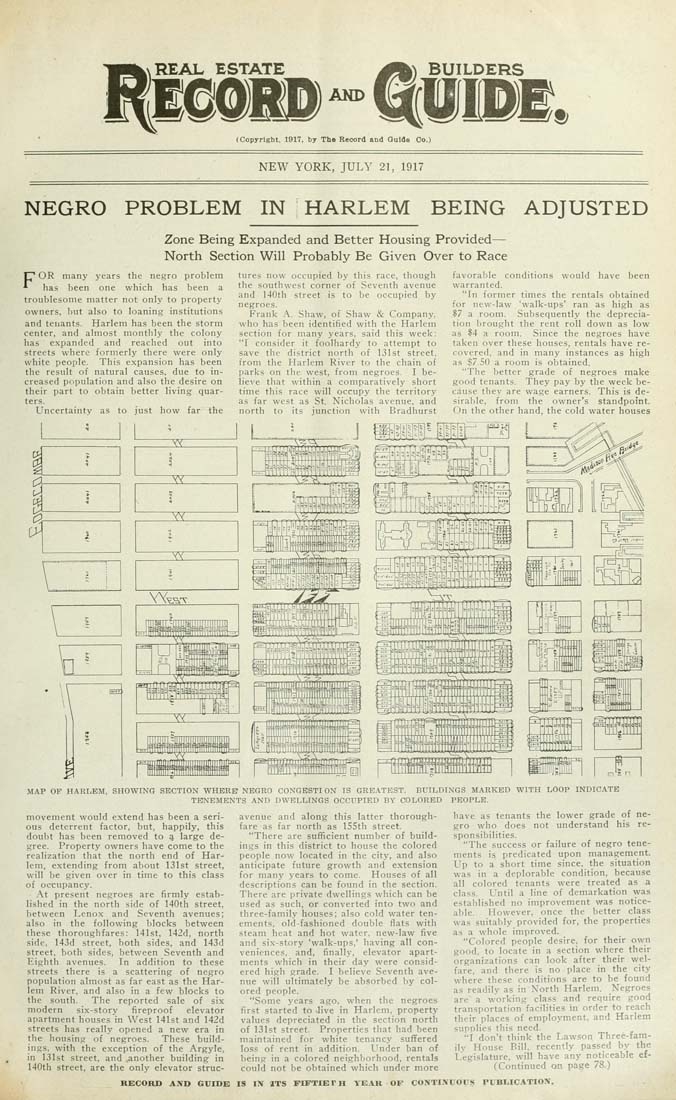Columbia University Libraries Digital Collections: The Real Estate Record
Use your browser's Print function to print these pages.
Real estate record and builders' guide: [v. 100, no. 2575: Articles]: July 21, 1917

Text version:
Please note: this text may be incomplete. For more information about this OCR, view About OCR text.
REAL ESTATE AND (Copyright. 1917, by The Record and Quids Co.) NEW YORK, JULY 21, 1917 NEGRO PROBLEM IN HARLEM BEING ADJUSTED Zone Being Expanded and Better Housing Provided— North Section Will Probably Be Given Over to Race r OR many years the negro problem * has been one which has been a troublesome matter not only to property owners, but also to loaning institutions and tenants. Harlern has been the storm center, and almost monthly the colony has expanded and reached out into streets where formerly there were only white people. This expansion has been the result of natural causes, due to in¬ creased population and also the desire on their part to obtain better living quar¬ ters. Uncertainty as to just how far the tures now occupied by this race, though the southwest corner of Seventh avenue and 140th street is to be occupied by negroes. Frank A. Shaw, of Shaw & Company, who has been identified with the Harlem section for many years, said this week: "I consider it foolhardy to attempt to save the district north of 131st street, from the Harlem River to the chain of parks on the west, from negroes. I be¬ lieve that within a comparatively short time this race will occupy the territory as far west as St. Nicholas avenue, and north to its junction with Bradhurst favorable conditions would have been warranted. "In former times the rentals obtained for new-law 'walk-ups' ran as high as $7 a room. Subsequently the deprecia¬ tion brought the rent roll down as low as $4 a room. Since the negroes have taken over these houses, rentals have re¬ covered, and in many instances as high as $7.50 a room is obtained. "The better grade of negroes make good tenants. They pay by the week be¬ cause they are wage earners. This is de¬ sirable, from the owner's standpoint. On the other hand, the cold water houses tua L IH ilL .J MAP OF HARLEM, SHOWING SECTION WHERE NEGRO CONGESTION IS GREATEST. BUILDINGS MARKED WITH LOOP INDICATE TENEMENTS AND DWELLINGS OCCUPIED BY COLORED PEOPLE. movement would extend has been a seri¬ ous deterrent factor, but, happily, this doubt has been removed to a large de¬ gree. Property owners have come to the realization that the north end of Har¬ lem, extending from about 131st street, will be given over in time to this class of occupancy. ■ At present negroes are firmly estab¬ lished in the north side of 140th street, between Lenox and Seventh avenues; also in the following blocks between these thoroughfares: 141st, 142d, north side, 143d street, both sides, and 143d street, both sides, between Seventh and Eighth avenues. In addition to these streets there is a scattering of negro population almost as far east as the Har¬ lem River, and also in a few blocks to the south. The reported sale of six modern six-story fireproof elevator apartment houses in West 141st and 142d streets has really opened a new era in the housing of negroes. These build¬ ings, with the exception of the Argyle, in 131st street, and .another building in 140th street, are the only elevator struc- avenue and along this latter thorough¬ fare as far north as 155th street. "There are sufficient number of build¬ ings in this district to house the colored people now located in the city, and also anticipate future growth and extension for many years to come. Houses of all descriptions can be found in the section. There are private dwellings which can be used as such, or converted into two and three-family houses; also cold water ten¬ ements, old-fashioned double fiats with steam heat and hot water, new-law five and six-story 'walk-ups.' having all con¬ veniences, and, finally, elevator apart¬ ments which in their day were consid¬ ered high grade. I believe Seventh ave¬ nue will ultimately be absorbed by col¬ ored people. "Some years ago. when the negroes first started to ^live in Harlem, property values depreciated in the section north of 131st street. Properties that had been maintained for white tenancy suffered loss of rent in addition. Lender ban of being in a colored neighborhood, rentals could not be obtained which under more have as tenants the lower grade of ne¬ gro who does not understand his re¬ sponsibilities. "The success or failure of negro tene¬ ments is predicated upon management. Up to a short time since, the situation was in a deplorable condition, because all colored tenants were treated as a class. Lhitil a line of demarkation was established no improvement was notice¬ able. However, once the better class was suitably provided for, the properties as a whole improved. "Colored people desire, for their own good, to locate in a section where their organizations can look after their wel¬ fare, and there is no place in the city where these conditions are to be found as readily as in North Harlem. Negroes are a working class and require good transportation facilities in order to reach their places of employment, and Harlem supplies this need. "I don't think the Lawson Three-fam- ilv House Bill, recently passed by the Legislature, will have any noticeable ef- (Continued on page 7S.) REICORD AND GXJIDK IS IN ITS FIFTIETH VE AR - OF CONTINUOUS PUBLICATION.